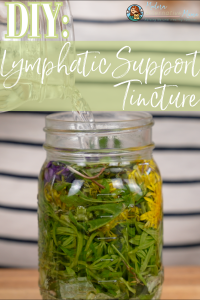Recipe by Kate Tietje and written by Sarena-Rae Santos, Natural Health Blogger
Whether you’re supporting whole body health, detoxing, or fighting an illness like strep throat, influenza, or a respiratory illness, lymphatic support is crucial. If you read our blog Helping Your Lymphatic System Flow (and Why it Matters), you know the lymphatic system is responsible for transporting hormones, fat, and fat-soluble vitamins; it’s even a huge part of our immune system. Unfortunately, in today’s world, environmental factors such as pollutants can cause sludge to hold up our lymphatic fluid resulting in congestion, which is associated with symptoms like:
- Swollen lymph nodes, arms, legs, genitals, face, neck, chest wall, and oral cavity
- Muscle soreness and pain
- Nerve pain
- Restricted range of motion in the joints
- Skin discoloration
- Heaviness of the limbs
- Difficult to fit into your size of clothes (calves or thighs much larger on one side, etc.)
Thankfully, there are many ways to support the lymphatic system and get things moving again, such as lymphatic massage, dry brushing, and Earthley’s Lymphatic Cream. You can even make your own lymphatic support tincture, which we will learn today.
Herb Benefits
Some of the ingredients will need to be wildcrafted for this recipe, so if you have a surplus of violets or dandelions in your yard, this recipe is for you!
Burdock
Burdock root, also known as Arctium lappa and sometimes called gobo, beggar’s buttons, love leaves, or clot-bur, is a bright pink-red to purple thistle-like flower with long stalks and huge hairy leaves that are native to Europe and Asia. Burdock root has been used throughout Western folk herbalism and traditional Chinese medicine for thousands of years, primarily for its cleansing and skin-smoothing properties.
Benefits of burdock include:
- Antioxidant properties
- Anti-inflammatory properties
- May lessen skin issues
- May remove toxins from the blood (purify blood)
- May help manage and prevent infections
- May improve blood sugar levels and diabetes
- Anticancer properties
Learn more about the benefits of burdock in our burdock herbal profile.
Cleavers
Cleavers, also known as Goosegrass, Barweed, Catchweed, Clivers, Grip Grass, Sticky-willy, Zhu Yang Yang, and their scientific name Galium aparine, are a part of the Rubiaceae (Madder) family. Cleavers are native to Eurasia but naturalized in Australia, Greenland, and parts of South and North America. Cleavers can be identified by their narrow, sticky, and bristle-like leaves and stems. Additionally, cleavers have clusters of tiny, star-shaped white to greenish flowers and bare fruits (burrs) covered with hooked hairs that cling to animal fur and clothing.
Benefits of cleavers include:
- Anti-inflammatory properties
- Wound-healing properties
- May reduce symptoms of psoriasis
- May promote lymphatic health
- May support kidney and bladder health
Learn more about the benefits of cleavers in our cleavers herbal profile.
Dandelion
Dandelions are also known as blowball, puffball, lion’s tooth, Pu gong ying, swine snout, wild endive, or their botanical name, Taraxacum officinale. Dandelions are native to Eurasia but have since been introduced to North America, South America, India, Australia, New Zealand, and other locations where Europeans have migrated. Dandelions are bright yellow flowers commonly known as weeds that are easily identifiable by the characteristic of their teeth-like leaves, which point back toward the center of the basal rosette.
Benefits of dandelion include:
- Highly nutritious
- May support healthy digestion
- May promote a healthy liver
- Rich in antioxidants
- May boost your immune system
- May help fight inflammation
- May aid in controlling blood sugar
- May reduce cholesterol
- May lower blood pressure
- May help fight cancer
Learn more about the benefits of dandelion in our dandelion herbal profile.
Violets
Violets are also known as the common violet, Devon violet, English violet, florist’s violet, fragrant, garden violet, sweet blue violet, sweet violet, wood violet, or its scientific name Viola odorata. Violets are usually dark blue or purple heart-shaped perennials that bloom in the late winter or early spring and are native to Europe, although grown worldwide. Traditionally, violets have been added to salads and turned into smoothies, jelly, and even tinctures.
Benefits of violets include:
- Antioxidant properties
- Antimicrobial properties
- Anticancer properties
- Neuroprotective properties
- Migraine control
- May promote sleep and relieve insomnia
- Antidiabetic properties
Learn more about the benefits of violets in our violet herbal profile.
Lymphatic Support Tincture
As with any tincture, the amounts are customizable, but this is what Kate used.
Ingredients:
- 10 oz. glycerin (I recommend this)
- 6 oz. hot water
- ¼ cup cleavers (I recommend these)
- ¼ cup dandelion flower
- 2 tbsp. dandelion leaves (I recommend these, but if you have the flower, you may also have the leaves)
- 1 tsp. violets
- 1 burdock leaf (I recommend these)
Directions:
Step 1: Add all of these herbs to a mason jar.
Step 2: Add the glycerin and hot water in a separate jar, and shake to mix until fully combined and clear.
Step 3: Pour the glycerin and water mixture over the herbs.
Step 4: Shake the mixture, cover it, and set it in a cool, dark place for about six weeks (or use the crockpot method).
Step 5: Strain it out and keep it in a glass bottle. In a perfect world, brown glass.


